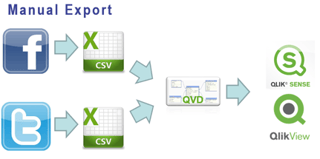The Internet is not only a network of connected computers, it connects people through Social Media, and daily objects through Internet of Things. How can we use this new information goldmine?
Our connected environment is evolving every day. The days when Analytics were reserved for a little group of data scientists are over. Every person in an organization has now the opportunity to analyze data, no matter its origin, and no matter its complexity. And the origin of the data sources is more and more shifting from internal data towards data available on the Internet.
This abundancy of data brings a new challenge: where to find the data, and how to make sure that it is relevant for the needs of the business user?
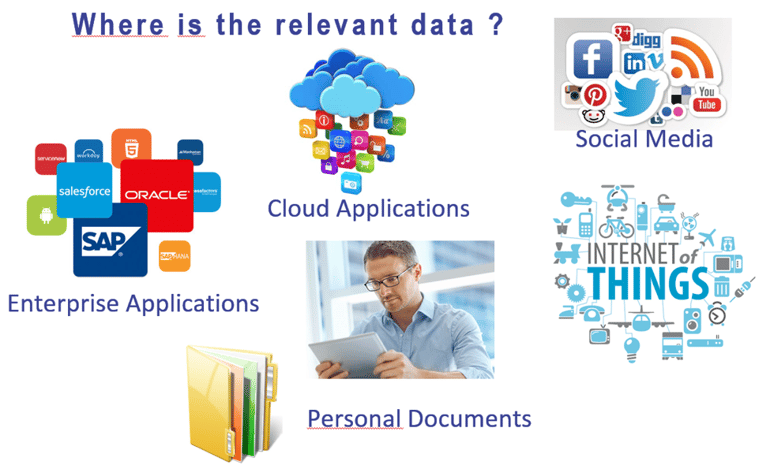
The data is stored in different locations:
- The major source remains internal enterprise applications, such as a company-wide ERP system, a CRM system, a data warehouse or local excel files. Usually, these applications are full of interesting information for the business user.
- More and more, organizations tend to replace their internally hosted applications by cloud based applications. This means that the cloud becomes a new data source for Analytics.
- Next to the cloud, the Internet is full of other information that could be pertinent for the business users. We will focus now on Social Media and Internet of Things.
Social Media Analytics
With the upcoming success of social media, many organizations start to understand that it can become very pertinent to analyze. Let’s first look at what we mean by Social Media Analysis.

The purpose is to transform the flow of information that can be found in public applications such as Facebook, Twitter, LinkedIn, YouTube and blogs, into structured information that brings insight. This allows you to answer questions like: « What are people thinking about my new brand? » or « Where is my company the most popular? »
This can be achieved by measuring the activity around a specific topic (for instance, the number of tweets posted), by evaluating the engagement (number of likes or shares), through sentiment analysis (comparing positive and negative posts) and analyzing the network (how are authors connected to the community). Showing these numbers in a dashboard will bring insight into the health of an organization. The real value though, comes in the combination of this information with internal data, such as activity monitoring or financial numbers.
For instance, when sales goes down in a particular region, analyzing the activity of the social media in this region will give indications on why this is happening, and more importantly, allow to take the appropriate actions to solve the problem.
Analyzing social media in this way means that you have different questions every time. The good news with data on the Internet is that it is always available. However, this immediate accessibility brings a new challenge: how can we quickly react to the change, while keeping the right associations with the internal company data? To achieve this, you need a flexible BI Tool, that allows a non-technical user to make the associations by himself.
This is exactly what the associative technology brought by Qlik is about: an interface where a business user can associate one information with another in a few clicks, and get an answer to his next question instantly.
There are several ways to connect Qlik to Social Networks:
- You can export the data from the different social networks to flat files, and exploit them like any other data source.
- You can also use the RESTful API connectors and gather directly the data from the applications.
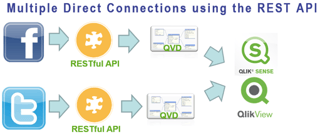
- The newly acquired Qlik Connectors (formerly known as QVSource) allows to easily combine multiple social network connectors with a sentiment analysis service such as Repustate for instance.
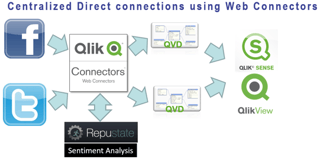
- To better prepare the data, a tool such as Alteryx can also gather the information directly, and blend it together to be visualized in Qlik
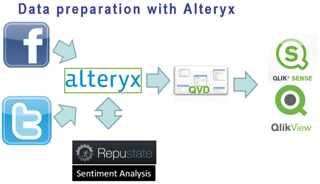
- Finally, you can leverage a social network content provider service such as talkwalker, by connecting your Qlik dashboards directly with their API service. The advantage of this solution is that the data already integrates multiple social networks (including blogs) and sentiment analysis information.
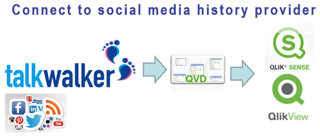
Once the data is loaded in a Qlik associative model, it can be leveraged and combined with internal data.
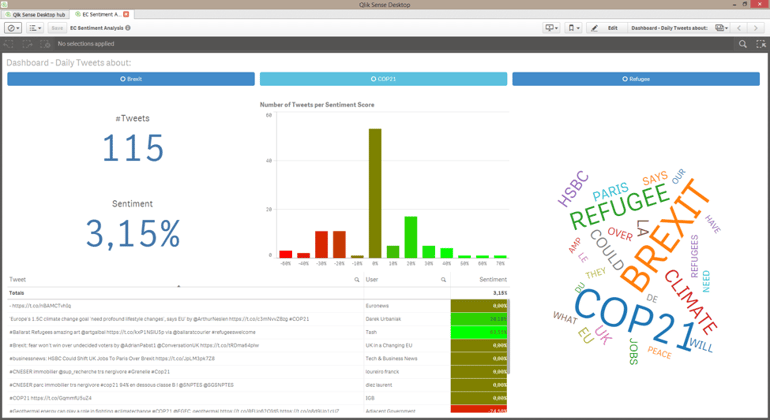
Internet of Things
The Internet of Things (IoT) is the network of physical objects that contain embedded technology to communicate and sense or interact with their internal states or the external environment (cf. http://www.gartner.com/it-glossary/internet-of-things/) . The McKinsey Global Institute defines IoT devices as those that “can monitor their environment, report their status, receive instructions, and even take action based on the information they receive.”
Like social media analytics, extending information with data coming from the Internet of Things will put this data in perspective, and greatly help to take appropriate actions.
The historical evolution of the Internet of Things started in 1982, with the first Internet connected appliance developed by the Carnegie Mellon University, who configured a Coke machine to report on inventory and drink temperature.
Later, in 1992, the IoT concept gains traction with the appearance of the RFID, QR-Codes and Digital Water Marks.
One had however to wait until 2010-2015 to see the public sector invest in this technology, through interconnected technologies for healthcare, social care and « smart cities ».
According to Gartner (http://www.gartner.com/newsroom/id/2905717), we have close to 5 billion devices that are connected, and we can expect to have 25 billion connected devices by 2020.
The top 3 industries that were using Internet of Things in 2015 are Manufacturing, Utilities and Transportation. DHL mentions that the total “Value at Stake” for supply chain and logistics operations over the next decade is estimated at 1.9 Trillion USD. (http://www.dhl.com/en/press/releases/releases_2015/logistics/internet_of_things_will_deliver_boost_to_supply_chain_and_logistics_operations.html)
Most executives understand how big data analytics can improve supply chain performance, but only a few have actually implemented analytics in one or more supply chain functions. With modern technologies, their devices are connected and can capture a lot of valuable information, and leveraging this information would enable them to optimize their supply chain.
Conclusion
With the exponential evolution of Internet technologies, we see new type of data appearing all over the Internet, through social media, and by the interconnection of billions of objects capturing information (Internet of Things). When this valuable information is combined with the internal data of a company using a flexible, agile tool such as Qlik, it will provide a new way to gain insight in the business of the organization. It allows to take appropriate actions to better manage and optimize the business processes, and become more successful in the future.



